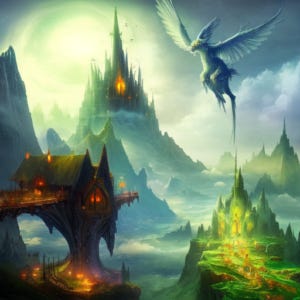Sunday Salutations and the P-Con Finale
This is Tod again (with major re-writes from Anna)! My lessons learned from P-Con are a little different and more is drawn a lot from my partial notes, so while I may often know the panel the thoughts are from, I rarely have the panelist. Sorry – next con I will take better notes. (I think it is fine, and I added details where I remembered as well. I think this will be our last P-Con post but hey the first con needed a lot of time to sink in. ~Anna)
My question for the week is: what is the best piece of information or opinion (as opposed to advice) you picked up at a con?
Supernatural
There were several panels on supernatural creatures, because we are writing in several fantasy settlings, we did focus on these panels.
Therefore, one of the first panels of interest to use was the vampire panel. In general, the panel was a discussion of what made a vampire in fiction good, and the other mythologies of vampires around the world. One panelist noted that New Guinea and South African vampire legends are unique and interesting. It was a little unclear what about them are so unique, so these are on my list of items to read up on.
But a major point was that most cultures had vampires of a sort and there was some fun speculation on why vampires show up in fiction so much. There was a split between panelists, per usual, about what makes a good vampire and how far one can push that before they are no longer a vampire, but just an uber-mensch if you will. Several panelists, including Monalisa Foster liked the movie Dracula Untold, in that it gave a different view of Vlad, as a person as well as a monster. Other panelists liked the take of Fred Saberhagen (of life killing mechanical Berserker fame) on vampires in the series that starts with The Dracula Tape.
There were some odd similarities between the dragon panel the next day and what made a dragon, and which also got spun into shifters. Genre monsters appear to interconnect. In this case, there was a long segway into dragon shifters. Interestingly, everyone on the panel seemed turned off by shifters having no cost to the transformation – either in pain or something. Just having the shifting as a costume without a cost or dealing with the animal instincts similarly appeared to be something people were not into. There appears to be a level of if a character is a dragon, it needs to be a dragon at heart if not in appearance.
In the panel on wizards, someone suggested “don’t define a term, but make it clear”. There was a long description of different types of magic users and why someone would use one term over another. But it really came down to reader expectations and the easiest way to handle that via world building.
Basically, if you want to call your magic users a witch-hobos, whisk-masters, or wizards, fine. Just declare the term and make sure it is clear. This doesn’t mean simply inserting a definition after the word but make the meaning of the word clear through use or a nice description phrase appended to it. A number of words for magic user all appear to convey different feelings to different speakers, which is why defining the term early and, in some cases, often was suggested.
More directly related to dragons: there was a lot said on dragons needing to have hordes – treasure or something else the dragon values. And dragons don’t mine their treasure, they take it. Finally, panelists liked the idea of northern dragons with fur. And much like in romance books, dragons are control freaks. (It is almost like people are using the different species of monster/supernatural as archetypes. ~Anna)
I think a lot of us in the room read romances with control freak dragons. Although, nobody but Anna and I seemed to have read Patricia Wrede’s Enchanted Forest Chronicles that start with Talking to Dragons. (Which I think is surprising, but what do I know? ~Anna)
And either in the vampire or dragons panel, I think related to making the bad guys relatable, someone recommended the biography of Michel Thomas, a resistance fighter and concentration camp survivor. I believe that is this book: https://www.ebooks.com/en-us/book/2172881/the-test-of-courage-michel-thomas/christopher-robbins/
Again, since our current novel settings are fantasy, we went to the panel on magic. Or as Anna would say, “because magic!” One panelist discussed the use of elemental magic. People liked the idea of combinations of elements in magic, like adding magnesium earth magic to fire magic to make the flames hotter.
And people liked magic with costs. Costs for power were a recurring theme, as with the shape shifters because while wanting supernatural, it felt fake or flat without there being a cost or burden to the power.
Another panelist pointed out that we as Westerns often think of 4-5 elements as air, wind, fire, water, and sometime aether/void (void being similar to the Japanese), but with the stronger world interactions different cultures have different elements. Chinese for example often use wood, metal, fire, earth, and water. (Which the Japanese use in their days of the week.)
It was also suggested that people read The Master and Margarita https://en.wikipedia.org/wiki/The_Master_and_Margarita for an interesting depiction of magic and magic users.
General Character and World Building
Two of the more nuts and bolts panels were the clothing panel and oddly the cussing panel.
In the clothing/costume panel, Monalisa Foster talked about using clothing as tells or tags for characters. If you have a character who is always fiddling with their cuffs, I assume French cuffs since those are most fidget-able (I believe it was lace and poufy cuffs from a different century but carry on. ~Anna), you don’t have to name the character, you can have them fiddle with their cuffs in the dialog tag. This also can convey the emotions of the person by adding character specific tells.
I asked about handling clothing knowledge like, in martial arts, there are more known ways to tie your hakama (blue or black split skirt/pants) than there are schools of martial arts. The consensus seemed to go with Monalisa’s response of “I don’t write for rivet counters.” The meaning is, don’t bother writing for the audience that is only there to find something to correct.
(I think she was suggesting that she wasn’t going to describe each fold that was required to tie it. Instead, the writer should cut the chase and say the character donned their hakama. Sometimes details get in the way, which is a point I need to remember. ~Anna)
Jonna, I think, recommended Bernadette Banner for fashion design. I found this book: https://www.ebooks.com/en-us/book/210266371/make-sew-and-mend/bernadette-banner/. (Hopefully, it is helpful because I do write a lot of non-historical fiction, but while I am not writing for rivet counters, I also do not want everyone throwing the book across the rooms because of how I have the characters wear corsets or not wear them… ~Anna)
The cussing panel was interesting for a number of reasons. We decided to go to the because Jane Lindskold was on it and Anna was hoping it would cover making your own fantasy cussing. It didn’t, until we asked.
The actual cussing started out slow, but after 20 minutes or so, was going pretty fluidly. (My ears burned at least once. Just kidding! But I tend to avoid cussing because I pick it up too fast. So, I avoid it when writing too. ~Anna)
One idea that received positive feedback was the idea that different cultures (or guilds) in a setting, should use different cusswords. The idea is to find what a culture in a setting finds shocking and use that. It ended up tying in a lot with how you build your world.
Animals
We also went to Cats and Animal Companions in Fiction panels. (Because have you read anything we have ever written? ~Anna)
I believe Stephen Patrick (The Holocaust Engine) said between panels that sand boas are cute, cuddly, and trainable. (I disagree, because Tod’s cuteness scale is heavily skewed. As is his talking to and emailing strangers scale. ~Anna)
Harking back to worldbuilding, Weber’s “cats” have six legs because, coming from a high-gravity world, they need the extra set of limbs in the middle to support the longish body.
What is interesting is, we often use animals in our fiction because of how much we love and adore then, but Fred was good enough to bring up that historically animal companions had practical uses. Cats used to be common on Navy ships to control vermin.
While not a true character in all fiction, animals duties and interaction with humans was culture based and they were a necessary part of a crew, having their own tasks. The crew had their own culture, including not being allowed to “just take a cat” instead a cat had to choose and board a ship of its own accord.
Side Notes
We found out Greg Gagnon’s father wrote books on Chippewa and Sioux magic and culture. https://www.ebooks.com/en-us/author/gregory-o.-gagnon/389094/ I plan to read these for more detailed information than generic “American Indian” culture, since as a Texan I understand, having had to often explain the difference between American, Texan, and Aggie culture to Japanese friends. (And I happen to enjoy finding out the difference in cultures. ~Anna)
Jane Lindskold
Jane Lindskold in her reading suggested you don’t have to tell a reader everything explicitly. You can have two characters that pick on each other. But character G loves his airship and lets character P fly it without a question. This tells you that P knows how to pilot an airship well without telling the reader that P is good at piloting an airship.
Jane also recommended making what you write, make it work double or triple. (Quotations are not exact here, they are made up by me.) The woman isn’t just “wearing a cobalt blue dress”, she “looks attractive in the blue dress that brings out her eyes”.)
Finale
So, those were my notes from the P-con (revamped and reordered a little by Anna to make it flow). Apologies to anyone I didn’t attribute information to, to anyone whose information was misattributed or misquoted, and to everyone whose information just plain escaped my horrible memory.
~Tod (and Anna)



